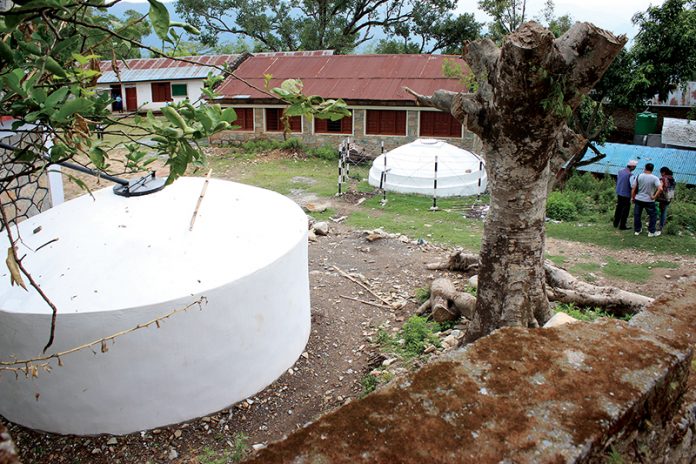
Rainwater harvesting, once seen as a quaint tradition of the rural poor, is growing in stature and scale, driven by urban demand, new mandates, economic incentives and the failures of centralised systems
By Vessela Monta*
Water risks have gone mainstream, but an affordable response to them still remains largely untapped. The World Economic Forum consistently ranks water scarcity alongside climate change, food crises and migration as a top Global Risk. It concludes that, unless water management changes, in 14 years human demand may exceed sustainable supply. The UN World Water Development Report 2015 goes further, showing where our current water management is failing. Even the last oasis, groundwater supplies, are diminishing, with a fifth of the world’s aquifers over-exploited.
If desalination is too costly, few sites remain for dams, and punching boreholes into the planet is not sustainable, where can we find resilient solutions?
Clear-sighted people are looking up and searching the sky for answers. They see rain and stormwater runoff not as looming liabilities to get rid of but rather as productive assets to manage and store.
In theory, rainwater falls under Integrated Water Resources Management. In practice, rainwater harvesting (RWH) is still regarded dismissively as an “ancient and marginal” method, at best relegated to rooftop collection and stored in a plastic tank.
Yet rainwater harvesting actually denotes the full spectrum of how we leverage rain to secure water through retention, recharge or collection for direct use. Done well, it will slow down runoff, alleviate flood risks, reduce erosion, and mitigate droughts.

Countries with a long history of rainwater harvesting are among the first to revive and prioritise it. Such countries grasp the urgency of action, and elevate harvesting into their portfolio of standard regulated water resources. In 2001, Hyderabad mandated it for all new buildings with a roof area above 300m2; other Indian cities require it for all public buildings, even if catchment surfaces are only 100m2.
New Delhi has enacted laws to build both rainwater collectors and percolation wells. Madhya Pradesh legislators introduced tax incentives for rainwater harvesting. Chennai provides new water and sewer connections only after the installation of collection systems. The Indian government’s inter-ministerial approach leads a long- term fight for harvesting to replenish groundwater reserves.
The mindset is spreading to Africa, albeit with difficulty. A decade ago, at the African Ministers Council on Water (AMCOW), a presentation by Mauritius marked the first step which led over the next three years to an advisory that member countries adopt rainwater harvesting as part of strategic public policy plans. Very few countries have done it. Political leadership still tends to gravitate toward centralised infrastructure. Meanwhile, tonnes of rain falls all at once, provoking urban floods, then stops just as suddenly, besieging cities in drought.
Mombasa’s sprawling population needs 182,000 m3/day, but water authorities can meet only about 30 percent of it, mostly by rationing what it borrows from neighbours, who rightly demand payment. Meanwhile, businesses, affluent families and investors can drill and pump freely from boreholes until sinking groundwater reserves run dry, grow saline, or are polluted by careless sanitation. In these cases, urban collection provides a complementary and clean source of water, improving living conditions while easing pressure on aquifers below.
Yet rainwater harvesting is not confined to emerging economies. In thirsty regions of the US, entrepreneurs and civil society embrace it as a way to relieve local water stress but a few states and counties still run into 19th century laws that restrict property owners from collecting and using rain that falls on their own roofs.

The legal concern is that intercepting rain may limit downstream access. But it doesn’t as a study in Douglas County, Colorado, shows that rainwater collection on private properties reduces streamflow by less than 3 percent. Meanwhile, it significantly reduces the demand from central facilities (whose conveyance pipes leak water) and recharges aquifer reserves for later.
Ironically, Atlanta, Georgia–in the rainy east–became the first city to establish formal regulations allowing rainwater to be used for potable water. This highlights a new dimension to rainwater harvesting: as political leadership falters, economic incentives pick up the slack. Collecting rainwater can spur job growth, and save money, through adoption of new technology. The American Rainwater Catchment Systems Association (ARCSA) and the American Society of Plumbing Engineers (ASPE) have teamed up to establish safe standards for implantation of rainwater, stormwater and greywater installations. Their efforts have helped redefine what had been a niche market into a full blown industrial sector.
Business growth in the US, Germany and Australia reinforces how rainwater harvesting is far from an inferior technology appropriate for the poor in developing countries, but rather a viable alternative for conventional, but not unique, water management practices.
It is time to start thinking beyond the bore well. As Elon Musk noted: “Some people don’t like change, but you need to embrace change if the alternative is disaster.”







